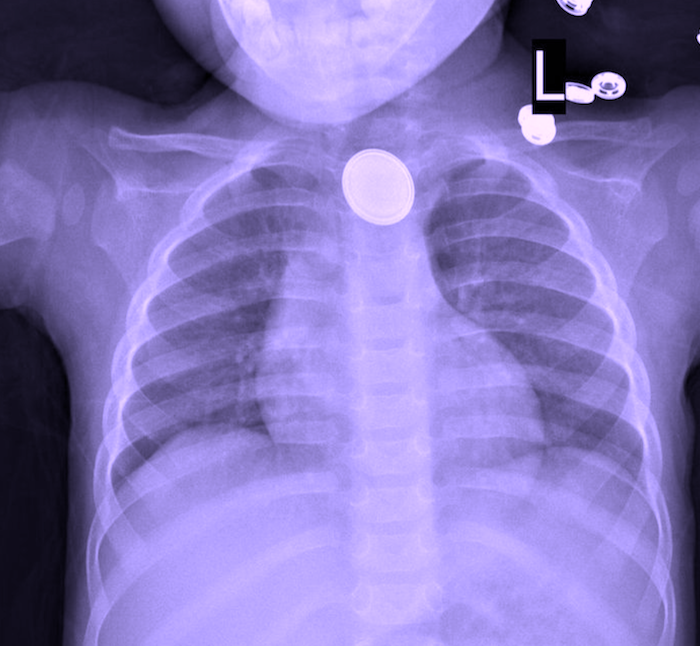 A team of ear, nose, and throat (ENT) specialists has demonstrated that eating honey after swallowing a button battery has the potential to reduce serious injuries in small children. Based on findings in laboratory animals, the research suggests that this common household product may significantly reduce morbidity and mortality from highly caustic batteries.
A team of ear, nose, and throat (ENT) specialists has demonstrated that eating honey after swallowing a button battery has the potential to reduce serious injuries in small children. Based on findings in laboratory animals, the research suggests that this common household product may significantly reduce morbidity and mortality from highly caustic batteries.
Button batteries are ingested by children more 2,500 times a year in the United States, with more than a 12-fold increase in fatal outcomes in the last decade compared to the prior decade.
According to Co-Principal Investigator, Ian N. Jacobs, MD, Director of the Center for Pediatric Airway Disorders and a pediatric otolaryngologist at Children’s Hospital of Philadelphia (CHOP), “Since serious damage can occur within two hours of ingesting a battery, the interval between ingestion and removal is a critical time to act in order to reduce esophageal injury.”
Jacobs collaborated with researchers at CHOP and Co-Principal Investigator, Kris R. Jatana, MD, a pediatric otolaryngologist and Director of Pediatric Otolaryngology Quality Improvement at Nationwide Children’s Hospital, in a study published online in The Laryngoscope.
Because of their size, candy-like shape and shiny metallic surface, button batteries have posed a risk for toddlers for decades. When the battery reacts with saliva and tissue of the esophagus, it creates a hydroxide-rich, alkaline solution that essentially dissolves tissue. Children with an esophageal button battery may present with symptoms of sore throat, cough, fever, difficulty swallowing, poor oral intake or noisy breathing. This can cause severe complications like esophageal perforation, vocal cord paralysis and erosion into the airway or major blood vessels. The longer it takes for the battery to be removed, the higher the risk for these children, particularly those without access to hospitals with specialized anesthesiologists and endoscopists experienced in removing foreign objects.
The research team wanted to determine successful interventions for mitigating these injuries in both a home and clinical setting and test their effectiveness in a live animal model, in this case, laboratory pigs. Specifically, the researchers sought palatable, more viscous liquids that could create a protective barrier between the tissue and the battery, as well as neutralize harsh alkaline levels. The team screened various options, including common household beverages such as juices, sodas, and sports drinks, in laboratory experiments.
“We explored a variety of common household and medicinal liquid options, and our study showed that honey and sucralfate demonstrated the most protective effects against button battery injury, making the injuries more localized and superficial,” said Jatana. “The findings of our study are going to be put immediately into clinical practice, incorporated into the latest National Capital Poison Center Guidelines for management of button battery ingestions.”
“Our recommendation would be for parents and caregivers to give honey at regular intervals before a child is able to reach a hospital, while clinicians in a hospital setting can use sucralfate before removing the battery,” Jacobs said. However, the authors caution against using these substances in children who have a clinical suspicion of existing sepsis or perforation of the esophagus, known severe allergy to honey or sucralfate, or in children less than one-year-old due to a small risk of botulism.
“While future studies could help establish the ideal volume and frequency for each treatment, we believe that these findings serve as a reasonable benchmark for clinical recommendations,” Jacobs said. “Safely ingesting any amount of these liquids prior to battery removal is better than doing nothing.”
“Button batteries are commonly found in households, and they should always be stored in a secured container, out of reach of children,” said Jatana. “Parents and caregivers should check all electronic products in the home and make certain that the battery is enclosed in a compartment that requires a tool to open and periodically check to ensure it stays secure over time.”
Source: Rachel R. Anfang, Kris R. Jatana, Rebecca L. Linn, Keith Rhoades, Jared Fry, Ian N. Jacobs. pH-neutralizing esophageal irrigations as a novel mitigation strategy for button battery injury. The Laryngoscope, 2018; DOI: 10.1002/lary.27312












[…] Source […]